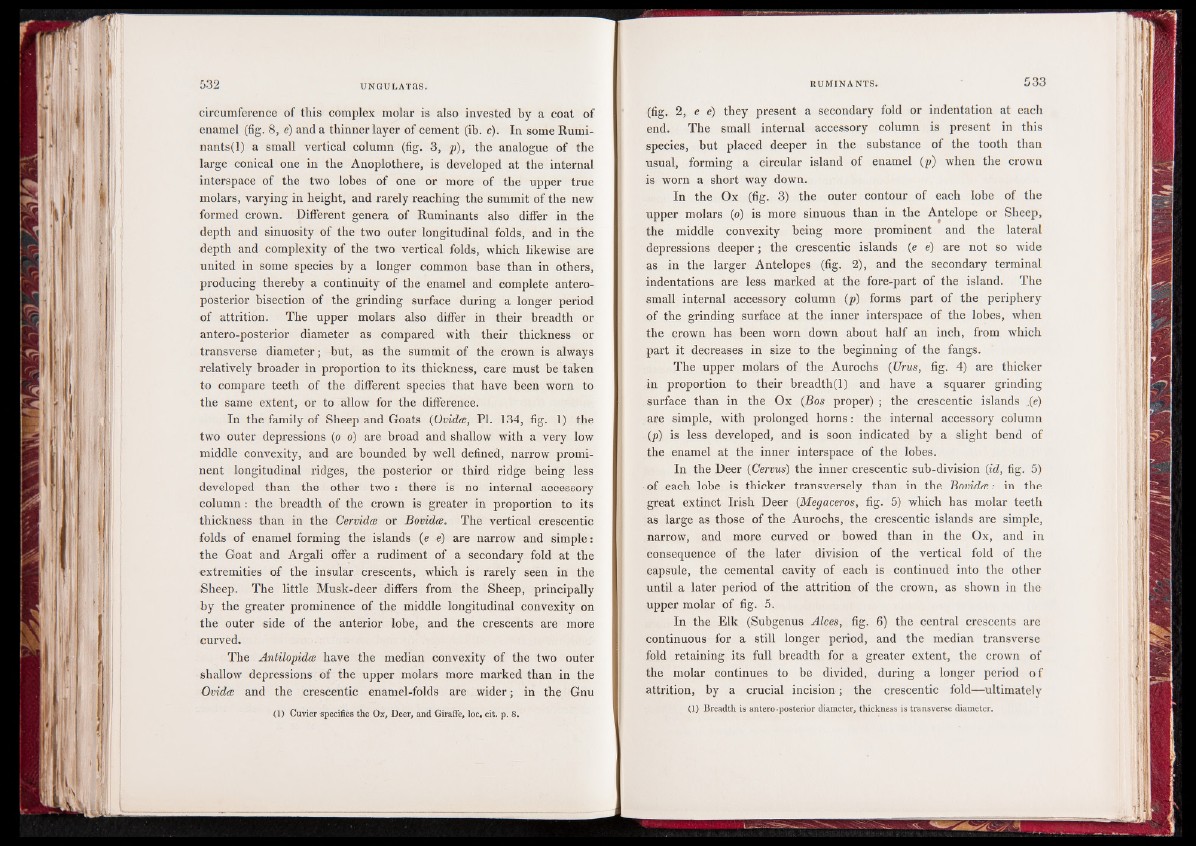
circumference of this complex molar is also invested by a coat of
enamel (fig. 8, e) and a thinner layer of cement (ih. c). In some Rumi-
nants(l) a small vertical column (fig. 3, p), the analogue of the
large conical one in the Anoplothere, is developed at the internal
interspace of the two lobes of one or more of the upper true
molars, varying in height, and rarely reaching the summit of the new
formed crown. Different genera of Ruminants also differ in the
depth and sinuosity of the two outer longitudinal folds, and in the
depth and complexity of the two vertical folds, which likewise are
united in some species by a longer common base than in others,
producing thereby a continuity of the enamel and complete anteroposterior
bisection of the grinding surface during a longer period
of attrition. The upper molars also differ in their breadth or
antero-posterior diameter as compared with their thickness or
transverse diameter; but, as the summit of the crown is always
relatively broader in proportion to its thickness, care must be taken
to compare teeth of the different species that have been worn to
the same extent, or to allow for the difference.
In the family of Sheep and Goats (Ovidce, PI. 134, fig. 1) the
two outer depressions (o o) are broad and shallow with a very low
middle convexity, and are bounded by well defined, narrow prominent
longitudinal ridges, the posterior or third ridge being less
developed than the other two : there is no internal accessory
column : the breadth of the crown is greater in proportion to its
thickness than in the Cervidas or Bovidee. The vertical crescentic
folds of enamel forming the islands (e c) are narrow and simple:
the Goat and Argali offer a rudiment of a secondary fold at the
extremities of the insular crescents, which is rarely seen in the
Sheep. The little Musk-deer differs from the Sheep, principally
by the greater prominence of the middle longitudinal convexity on
the outer side of the anterior lobe, and the crescents are more
curved.
The Antilopidee have the median convexity of the two outer
shallow depressions of the upper molars more marked than in the
Ovidee and the crescentic enamel-folds are wider; in the Gnu
<1) Cuvier specifies the Ox, Deer, and Giraffe, loc. cit. p. 8.
(fig. 2, e e) they present a secondary fold or indentation at each
end. The small internal accessory column is present in this
species, but placed deeper in the substance of the tooth than
usual, forming a circular island of enamel (p) when the crown
is worn a short way down.
In the Ox (fig. 3) the outer contour of each lobe of the
upper molars (o) is more sinuous than in the Antelope or Sheep,
the middle convexity being more prominent and the lateral
depressions deeper; the crescentic islands (e e) are not so wide
as in the larger Antelopes (fig. 2), and the secondary terminal
indentations are less marked at the fore-part of the island. The
small internal accessory column (p) forms part of the periphery
of the grinding surface at the inner interspace of the lobes, when
the crown has been worn down about half an inch, from which
part it decreases in size to the beginning of the fangs.
The upper molars of the Aurochs (Urus, fig. 4) are thicker
in proportion to their breadth(l) and have a squarer grinding
surface than in the Ox (Bos proper) ; the crescentic islands (e)
are simple, with prolonged horns: the internal accessory column
(p) is less developed, and is soon indicated by a slight bend of
the enamel at the inner interspace of the lobes.
In the Deer (Cervus) the inner crescentic sub-division (id, fig. 5)
of each lobe is thicker transversely than in the Bovidee: in the
great extinct Irish Deer (Megaceros, fig. 5) which has molar teeth
as large as those of the Aurochs, the crescentic islands are simple,
narrow, and more curved or bowed than in the Ox, and in
consequence of the later division of the vertical fold of the
capsule, the cemental cavity of each is continued into the other
until a later period of the attrition of the crown, as shown in the
upper molar of fig. 5.
In the Elk (Subgenus Aloes, fig. 6) the central crescents are
continuous for a still longer period, and the median transverse
fold retaining its full breadth for a greater extent, the crown of
the molar continues to be divided, during a longer period of
attrition, by a crucial incision ; the crescentic fold—ultimately
(1) Breadth is antero -posterior diameter, thickness is transverse diameter.